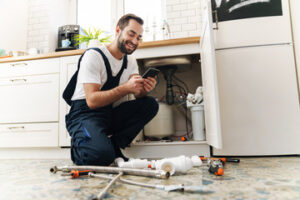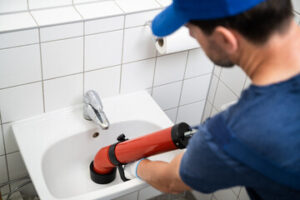Pro Plumbing Orillia is a system of pipes and fixtures that distributes water and removes waste. It is regulated by the Environmental Protection Agency (EPA) and involves local regulations. It is important for plumbers to understand these regulations when working on plumbing projects.

One of the best ways to prevent drain clogs is to limit what goes down the drains. This can help reduce the buildup of hair, grease, and other debris.
Plumbing systems are the infrastructure that delivers clean water to homes and businesses, and removes wastewater. They are composed of pipes, fixtures, fittings, and valves that connect to appliances and ductwork. These systems are essential for indoor cleanliness and hygiene, ensuring the safety of people and equipment in the building. Plumbing also helps prevent environmental damage by preventing groundwater contamination and soil erosion. In addition, plumbing systems control indoor humidity levels to protect surfaces from mold and other respiratory diseases.
A reliable plumbing system is essential for a healthy life. Without it, we would be stuck with dirty water that could lead to infections and other health issues. It is important to have a professional plumber perform regular maintenance on your home’s plumbing system. This will keep it running smoothly and prevent problems such as clogged drains, leaky faucets, or overflowing toilets.
Residential plumbing systems are typically made up of two separate subsystems: the water supply and the drainage system. The water supply subsystem brings freshwater into the house and distributes it to all outlets. It includes main supply lines, distribution pipes, and a network of branch pipes that connect to sinks, showers, and tubs. The drainage system removes waste water and sends it to the sewer or septic system. It includes drain pipes, traps, and vents.
Both the water supply and drainage systems are regulated by national plumbing codes, which set minimum standards for pipe dimensions, materials, and installation. These codes ensure that the plumbing system complies with local building codes and is safe for use.
Commercial plumbing is a highly skilled trade that requires in-depth knowledge of the construction and operation of buildings and their piping systems. In addition, it requires attention to detail and a commitment to safety. It is also important for plumbers to understand the environmental and regulatory issues that may affect the design and construction of a plumbing system.
Plumbing is a rewarding career that provides good pay and job security. In addition, it offers opportunities for advancement and flexibility in work schedules. However, it can be physically demanding and require plumbers to lift heavy objects and stand for long periods of time. It is important for plumbers to prioritize their physical health and take breaks when needed.
It involves the installation and maintenance of plumbing systems
Plumbing is the system of pipes and fixtures that facilitates water supply, waste management, and heating in buildings. Plumbers install and repair these systems to ensure they work properly and safely. They also use specialized tools and techniques to perform their jobs. In addition, they must understand building codes and regulations to ensure plumbing installations comply with local safety and sanitation standards. Local regulations often include specific requirements for water conservation and seismic safety.
The three main components of a home’s plumbing system are the water supply, the drainage system, and the venting system. The water supply line connects to a municipal water meter and carries drinking water throughout the house. It is then distributed to individual fixtures and appliances, such as sinks, bathtubs, showers, and toilets. The drain line carries wastewater and sewage to the sewer or septic system. The venting system allows air to escape the drainpipes, preventing the buildup of pressure and the release of hazardous gases.
Keeping these systems in good working order requires regular maintenance from experienced and licensed plumbers. This can help reduce energy costs, prevent leaks and water damage, and ensure that the home’s occupants are safe from health risks.
While a plumbing system may seem complex, its basic principles are easy to understand. A basic understanding of gravity and pressure can help you avoid costly plumbing repairs. A good plumber will also be able to identify problems and recommend solutions before they become serious.
In addition to being skilled at installation and maintenance, a plumber must be comfortable with the demands of the job. This can be challenging for some people, as it often involves an unpredictable schedule and emergency situations. It can also require a large amount of manual labor, such as moving heavy objects and climbing ladders.
The most important function of a plumbing system is to provide a clean, potable water supply. The most common cause of contaminated drinking water is from cross-piping connections. These connections can occur when a plumber installs new fixtures or changes the layout of a kitchen or bathroom. A good plumber will make sure all connections are secure and watertight to protect against contamination.
It is regulated by the Environmental Protection Agency (EPA)
The Environmental Protection Agency (EPA) is responsible for setting standards and regulations that ensure water quality. These include rules for drinking water and wastewater disposal, as well as treatment techniques. These standards help to prevent contamination, as well as to conserve and recycle resources. The EPA also monitors air pollution, ensuring compliance with environmental laws. The EPA works in partnership with other agencies to set standards and policies that protect the environment.
The plumbing system in a home is made up of pipes, valves, fixtures, and appliances. It begins with a main water line connecting to the home’s municipal water supply or a private well. This line distributes water throughout the house, supplying faucets, toilets, showers, and sinks. Each fixture is equipped with shut-off valves to control water flow and pressure. Wastewater from these fixtures is directed into drain pipes, which connect to the home’s sewer lines or septic tanks. The EPA regulates the piping and installation of plumbing fixtures to ensure health, safety, and sanitation.
EPA regulations apply to both residential and commercial plumbing. For example, the EPA requires that lead-free pipes be used in drinking water systems to reduce exposure to toxic substances. It also regulates the use of chemicals and disinfectants in water systems to prevent bacterial contamination, such as the Legionella bacteria. The EPA also sets standards for backflow prevention, which protects potable water from contamination from non-potable sources like toilets and sprinklers.
The EPA also regulates the plumbing industry by setting standards for plumber training and licensing requirements. Its licensing requirements ensure that all plumbers meet minimum educational and professional standards. This helps to prevent unsafe practices and shoddy work, protecting the public from injuries and illnesses. It also promotes sustainable plumbing practices through its Green Plumbers program.
Despite their similar appearance, plumbing and process piping have distinct functions and different regulatory needs. Plumbing brings water and waste into a building, while process piping moves gases, chemicals, and water from one location to another during the manufacturing process. Therefore, it’s important for plumbers to understand the difference between the two systems.
It involves local regulations
Plumbing involves a wide range of skills that are vital for keeping homes and businesses safe. From installing faucets to repairing sewage systems, plumbers must adhere to local and national standards. They also must obtain proper permits and follow strict guidelines when performing installations or modifying existing plumbing. Failure to do so can lead to costly fines or project delays. Fortunately, working with licensed professionals can help you navigate these requirements effectively.
The New York State plumbing code has specific regulations that cover a variety of aspects of the plumbing system, including safety measures and public health standards. It also outlines specific requirements for specific occupancies, such as psychiatric facilities, first aid stations, and clinics. In addition, it includes provisions for sanitary drainage systems and backflow prevention devices. This code requires that all drainpipes slope downward to prevent water from backing up into structures and that they have a pitch of at least 1/4 inch per foot in residential areas.
Practicing a skilled trade like plumbing is a great way to provide a stable income for families. In addition, it can help you gain valuable technical and interpersonal skills that are useful in any career path. To become a plumber, you can pursue certification programs at local colleges or trade schools. Many programs offer classroom instruction and hands-on training, which can help you develop your skills. You can also pursue an apprenticeship, which lasts a few years and combines on-the-job experience with classroom learning. Many apprenticeships are sponsored by trade unions and include health benefits, paid vacation time, and training opportunities.
To be a successful plumber, you should have a strong desire to work with your hands and learn from others. You should be able to solve problems and communicate effectively, especially when working with customers. You should also be able to adapt to changing conditions in the workplace. You should also be able to handle pressure, as this can affect the quality of your work. You can learn these skills through a vocational school, community college, or trade union, and by working as an assistant to a master plumber.


